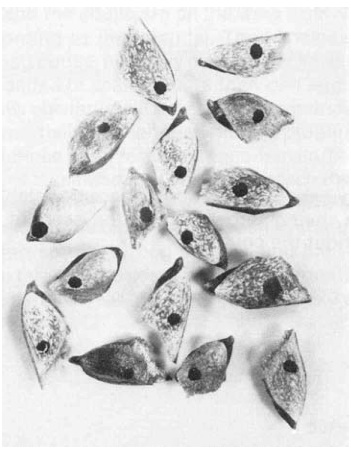PESTS AND DISEASES OF FORESTRY IN NEW ZEALAND
Douglas Fir Seed Chalcid
Scion is the leading provider of forest-related knowledge in New Zealand
Formerly known as the Forest Research Institute, Scion has been a leader in research relating to forest health for over 50 years. The Rotorua-based Crown Research Institute continues to provide science that will protect all forests from damage caused by insect pests, pathogens and weeds. The information presented below arises from these research activities.
Forest and Timber Insects in New Zealand No. 14: Douglas fir seed chalcid.
Revised 2009
Based on J. Bain (1977)
Insect: Megastigmus spermotrophus Wachtl (Hymenoptera: Chalcidoidea: Torymidae)

Fig. 1 - Emergence holes of Megastigmus spermotrophus in Douglas fir seed.
Type of injury
The larvae of Megastigmus spermotrophus eat the contents of Douglas fir seed.
Host
Pseudotsuga menziesii (Douglas fir) is the only host.
Distribution
Megastigmus spermotrophus probably became established in New Zealand in the 1920s, being introduced in the seed of Douglas fir. It is distributed throughout the country.
Economic importance
Generally the effect of this insect on Douglas fir seed-production is not great but locally in certain years the losses can exceed 20%. Losses are worst in poor seed years as then the percentage of seed attacked is greatest. A considerable amount of effort can be wasted collecting non-viable seed. Consequences of depredations by M. spermotrophus will probably be felt more as increasing amounts of Douglas fir seed come from seed orchards rather than from seed collection in forests. The concentration of potential host material in seed orchards may result in an increase in numbers of this chalcid.
Description, life history, and habits
The small (3.0 - 3.5 mm long) adults have two pairs of transparent wings which appear to lack veins. The forewings have a large black spot (stigma) near the leading edge. The antennae are elbowed. The long upcurved ovipositor (egg-laying drill) of the female is a distinctive feature. Females are uniformly brownish-yellow whereas males are a lemon-yellow with black markings on the head. The larva is a small, white, legless, wrinkled grub. The head is white with dark jaws which in the larger larvae are noticeably toothed.
In New Zealand the adults are on the wing from September to October (this varies according to the latitude). The females oviposit in the seeds contained in young cones, normally one egg per seed. When the insects are abundant and seeds are scarce, more than one egg may be deposited in each seed but only one larva will develop, the remainder dying of starvation Reproduction is partially parthenogenetic, the progeny of unfertilised eggs being male and those from fertilised eggs female. The egg hatches in 3 days and the larva takes about 6-7 weeks to reach the fifth and final stage, by which time the entire contents of the seed have been destroyed. After completion of feeding the larva enters a resting stage which normally lasts until the following spring. It then pupates and the resulting adult cuts a circular exit hole through the seed coat and emerges (Fig. 1). The majority of the adults appear after one year but some can emerge two and even three years after oviposition.
The amount of seed destroyed in any year is variable. The most important cause of this is the stage of development reached by the Douglas fir cones when the adult insects are on the wing. The female can lay eggs only during a period of 2-3 weeks when the cones are green and about 40- 80 mm long. Cones younger than this do not attract M. spermotrophus and when the cones reach the stage when the ovuliferous scales are brownish the tissues are too tough to permit oviposition.
Control
There are no parasites of M. spermotrophus known to be established in New Zealand. In the 1950s unsuccessful attempts were made by the Forest Research Institute to establish a pteromalid parasite, Amblymerus apicalis Thompson. This parasite exerts considerable control on M. spermotrophus in some areas of Great Britain, especially when the host population is high.
Experiments in the United States have shown that the use of systemic insecticides in seed orchards can give some degree of control of this pest.
Bibliography
Bain, J. 1977: Megastigmus spermotrophus Wachtl (Hymenoptera: Chalcidoidea: Torymidae). New Zealand Forest Service, Forest and Timber Insects in New Zealand No. 14.
Hussey, N.W., 1954: "Megastigmus flies attacking conifer seed". Forestry Commission Leaflet 8, H.M. Stationery Office, London.
Johnson, N.E. and Rediske, J.H. 1965: A test of systemic insecticides to control Douglas fir cone and seed insects. Journal of Economic Entomology 58: 1020-1021.
This information is intended for general interest only. It is not intended to be a substitute for specific specialist advice on any matter and should not be relied on for that purpose. Scion will not be liable for any direct, indirect, incidental, special, consequential or exemplary damages, loss of profits, or any other intangible losses that result from using the information provided on this site.
(Scion is the trading name of the New Zealand Forest Research Institute Limited.)

 Farm Forestry New Zealand
Farm Forestry New Zealand

